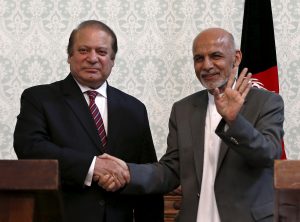On May 18, Pakistan’s Army spokesman, Major General Asim Bajwa, took to Twitter to make a major announcement. General Bajwa tweeted that the intelligence agencies of Afghanistan and Pakistan had signed a memorandum of understanding that calls for intelligence sharing and coordinated counterterrorism operations.
The deal’s signatories were as striking as the deal itself. For decades, Afghanistan and Pakistan have suffered through a tense and tumultuous relationship. And yet here they were signing a deal requiring close cooperation and immense levels of trust.
A Legacy of Rocky Relations
Much ink has been spilled over Pakistan’s troubled relations with India, its neighbor to the east. Less has been said, however, about Islamabad’s difficult relationship with its neighbor to the west.
Historically, the chief driver of Afghanistan-Pakistan tensions has been their disputed border, the 1,500-mile Durand Line. It is a border that Kabul has refused to recognize since the day in 1893 when a British colonial official in India, Sir Henry Mortimer Durand, demarcated the frontier between Afghanistan and British India. Following the establishment of this new border, ethnic Pashtun tribal areas (now the Federally Administered Tribal Areas, or FATA) reverted to British – and, in due course, Pakistani – control. Afghanistan continues to claim these areas as its own.
The Durand Line is a highly porous border, and over the years many Afghan refugees fleeing conflict have crossed to the Pakistani side. Afghan officials have accused Pakistan of discriminating against these refugees (which number about 3 million in total), further fueling bilateral tensions. This year, authorities in Islamabad have suggested that they plan to repatriate many of them.
In recent years, the Taliban insurgency in Afghanistan has arguably become the chief source of bilateral tensions. Kabul has repeatedly accused Pakistan’s security establishment of destabilizing Afghanistan through its support of the Afghan Taliban and the Haqqani Network, including through the provision of sanctuaries in FATA and elsewhere in Pakistan. The Afghan Taliban’s top leadership is based in Quetta, though some top-ranking figures may be in Karachi. In 2013, Nasiruddin Haqqani, a Haqqani Network leader, was shot dead near Islamabad – which is not far from Rawalpindi, the location of Pakistan’s military headquarters and a city where some believe other Haqqani leaders are based.
Bilateral relations have been so fraught in recent years that some observers have raised the possibility of war, based on the assumption that Afghan forces could launch an offensive against Afghan Taliban sanctuaries in FATA and trigger Pakistani retaliatory strikes in Afghanistan. Such a scenario wildly overstates the capacities of Afghan security forces. Still, in recent years, militants have staged cross-border raids from both sides of the Durand Line. There is reason to fear that tit-for-tat cross-border shelling by each country’s military could escalate into something more serious.

































